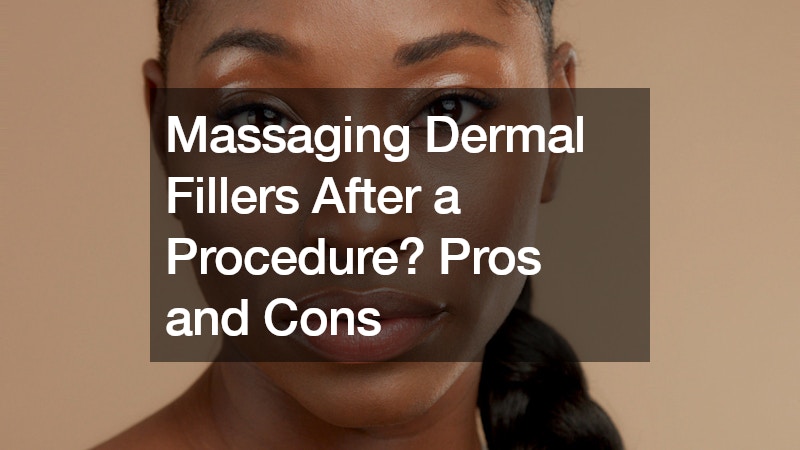In the realm of cosmetic enhancements, dermal fillers have gained immense popularity for their ability to address wrinkles, volume loss, and contour irregularities, providing individuals with a more youthful appearance. However, post-procedure care, including the decision to massage the treated area, plays a significant role in achieving optimal results. Let’s delve into the pros and cons of massaging dermal fillers after a procedure to better understand its implications.
Pros of Massaging Dermal Fillers:
1. Addressing Lumps and Bumps: One of the primary benefits of massaging dermal fillers post-procedure is the ability to address any lumps or bumps that may arise.
While most fillers integrate well within the first few weeks, massaging can expedite this process, leading to a smoother and more natural-looking outcome.
2. Enhanced Integration: Massaging encourages better integration of the filler into the surrounding tissue, promoting a seamless transition between the treated and untreated areas. This can result in a more uniform appearance and reduce the risk of palpable filler.
3. Improved Symmetry: In cases where asymmetry is observed post-procedure, targeted massaging can help correct minor discrepancies, ensuring a more balanced and harmonious facial profile. It allows for subtle adjustments to achieve symmetry without the need for additional injections.
4. Increased Patient Satisfaction: By addressing any concerns promptly and proactively, massaging dermal fillers can enhance patient satisfaction. Patients are more likely to be pleased with the final outcome when their concerns are acknowledged and effectively managed through techniques like massaging.
Cons of Massaging Dermal Fillers:
1. Risk of Overcorrection: While massaging can help smooth out lumps and bumps, there is a risk of overcorrection if too much pressure is applied or if the filler is excessively manipulated. This may lead to unintended changes in facial contour or volume, resulting in an unnatural appearance.
2. Potential for Adverse Reactions: Aggressive massaging techniques or improper handling of the treated area can increase the risk of adverse reactions, such as bruising, swelling, or tissue damage. It’s essential to exercise caution and use gentle, controlled movements to minimize these risks.
3. Compromised Aesthetic Results: In some cases, massaging dermal fillers may inadvertently compromise the aesthetic results achieved during the initial treatment. Improper technique or excessive manipulation can alter the placement of the filler, leading to a suboptimal outcome that may require corrective measures.
4. Limited Efficacy for Certain Fillers: Not all dermal fillers require massaging for optimal results. While it may be beneficial for hyaluronic acid-based fillers, which are commonly used for lip augmentation, cheek enhancement, and wrinkle reduction, other types of fillers, such as collagen stimulators, may not respond well to massaging.
Precautionary Measures:
Before undergoing dermal filler procedures, it’s crucial for patients and practitioners to adhere to precautionary measures to minimize the need for post-procedure massaging. One fundamental aspect is the pre-procedural assessment, where healthcare providers thoroughly evaluate the patient’s medical history, skin condition, and aesthetic goals. By carefully selecting suitable candidates and identifying any contraindications, practitioners can reduce the likelihood of complications that may necessitate post-procedure interventions like massaging.
Additionally, patient education plays a pivotal role in preventing the need for excessive massaging after dermal filler treatments. Informing patients about realistic expectations, potential side effects, and proper post-procedure care can empower them to actively participate in their recovery process and recognize any abnormal signs that may require professional attention. Moreover, encouraging patients to follow pre-procedure guidelines, such as avoiding certain medications or activities, can contribute to smoother outcomes and minimize the risk of adverse events that might necessitate post-procedure interventions.
Long-Term Considerations:
Considering the long-term effects of massaging dermal fillers is essential for both patients and practitioners. While massaging can help address immediate concerns like lumps or asymmetry shortly after the procedure, it’s crucial to recognize its potential impact on filler longevity and tissue response over time. Excessive or aggressive massaging may disrupt the structural integrity of the filler and contribute to premature degradation or uneven distribution within the tissues.
Moreover, repeated manipulation of the treated area through massaging can trigger inflammatory responses and fibrotic reactions, leading to the formation of nodules or irregularities in the skin texture. Healthcare providers should educate patients about the importance of gentle post-procedure care and discourage excessive touching or manipulation of the injected sites. Emphasizing the significance of long-term follow-up appointments can also help monitor the evolution of filler effects and address any emerging concerns promptly. Ultimately, striking a balance between immediate aesthetic improvements and long-term tissue health is crucial for optimizing the outcomes of dermal filler treatments.
Conclusion:
In conclusion, massaging dermal fillers after a procedure can offer several benefits, including addressing lumps and bumps, enhancing filler integration, and improving symmetry. However, it’s essential to weigh these potential advantages against the associated risks, such as overcorrection, adverse reactions, and compromised aesthetic results. Clinicians should exercise caution and tailor their approach to each patient’s unique needs, considering factors such as filler type, treatment area, and individual anatomy. By striking the right balance between therapeutic intervention and conservative management, clinicians can optimize patient outcomes and ensure a positive experience with dermal filler treatments.
.

